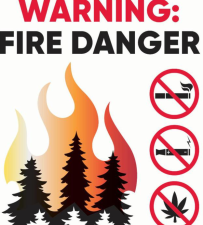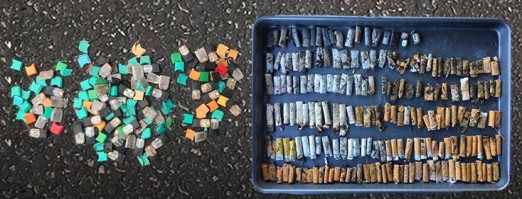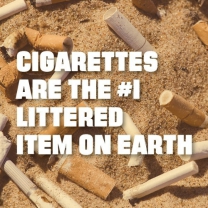Tobacco and Cannabis smoking and vaping cause preventable fires. Please help prevent fires during this high risk fire season, by avoiding lighting up flammable and combustable substances. Vapes can explode when overcharged, and these also cause fires.
Check out Undo.org for more ways that tobacco and vapes impact our environment! UNDO.ORG
Impact of Tobacco and E-Cigarettes on the Environment including Air Pollution
Smoke-Free Marin Coalition member Dr. Jeremiah Mock's study was published UCSF professor and Marin County Resident Leads Path-breaking Study on Hazardous Waste and Teen Use of E-cigarettes, Tobacco, and Cannabis on High School Grounds and Surrounding Areas.
The garbology study shows the environmental health hazards and fire risks from teens disposing waste from using e-cigarette, cigarettes, little cigar and cigarillos, and cannabis products. E-cigarette and cannabis vaporizer devices with lithium-ion batteries turn into toxic waste. They can be highly flammable and start fires when improperly discarded. Fire authorities say that cigarette butts are one of the leading causes of grass and structure fires. Smoldering little cigar and cigarillos can also ignite fires. The study demonstrates the importance of eliminating sources of contamination and combustion from use of these products.
The study was published on Oct. 10, 2019 in Morbidity and Mortality Weekly Report (MMWR), the principle journal of the federal Centers for Disease Control and Prevention. National newspapers including CNN and Time Magazine have published his study. Recently, California’s Capitol Weekly included it in a statewide weekly update: https://capitolweekly.net/study-raises-concern-about-e-cigarette-waste/
Jeremiah Mock, PhD, Associate Professor at UCSF School of Nursing and member of the Smoke-Free Marin Coalition led the study, conducted with Dr. Yogi Hendlin a public health scientist and environmental philosopher with appointments at Erasmus University Rotterdam and UCSF’s Environmental Health Initiative, a Gia Asher, a high school intern, and members of Marin Healthy Youth Partnerships, a community-based collation.
This study identified environmental contamination from e-cigarette product waste, combustible tobacco product waste, and cannabis product waste using a selected sample of 12 public high schools with a total enrollment of 18,831 students in Alameda, Contra Costa, Marin, and San Francisco counties in California.
The study is the first to report empirical data on e-cigarette waste contamination of areas that drain into creeks, estuaries and other sensitive ecological zones in the San Francisco Bay and Pacific Ocean.
“We’re in the midst of an epidemic of teen e-cigarette use that is causing substantial toxic waste contamination at some high schools from teens discarding these products on the ground,” said Mock.
The study is also the first to report on empirical findings of cannabis product waste contamination. At the high schools, researchers found cannabis oil concentrates vaporizer cartridges, such as those manufactured in California by licensed cannabis companies.
“The cannabis industry has been pushing these products out into market, but nobody seems to be talking about their environmental impact once they are used,” Mock said.
The study also demonstrates that flavored e-cigarettes, particularly mint and mango, and other flavored tobacco products are used by teens.
“Our study novelly detected the under-addressed problem of flavored little cigars and cigarillos in low-income youth populations,” said co-author Hendlin.
The UCSF researchers and student interns collected nearly 900 waste items at 12 high school student parking lots and perimeter areas, and found:
- About 19 percent of the total waste product originated from e-cigarettes – nearly all of the e-cigarette waste came from JUUL or JUUL-compatible pods and pod caps.
- Much of the JUUL products were found in schools from middle- and upper-income areas.
- 73 out of 74 pod caps (nearly 99 percent) came from flavored pods other than tobacco flavors and they included “Cool Mint,” “Cool Cucumber,” and “Classic Menthol” flavors.
- Four of the 12 high schools in the study had predominantly student populations from lower-income African American and Latinx communities.
- In those 4 schools the study found 71 little cigar or cigarillo plastic packages and mouthpieces; no such items were found at upper-income area schools.
- Over 600 cigarette butts were collected from all 12 high schools; 65 percent of these cigarette butts were identifiably from recently smoked cigarettes.
Pam Granger, Chair of the Smoke-Free Marin Coalition, applauded the study: “This study is highly relevant in the midst of the national e-cigarette epidemic since there have been so many nicotine and cannabis lung injuries and deaths. Now it turns out that it’s not just teens and adults that get hurt, it’s the environment too!”
Tobacco waste contributes to ground water pollution. According to the Truth Initiative, e-cigarettes, like JUUL, can leak heavy metals and residual nicotine into the environment. Because of heavy metals and residual nicotine, e-cigarettes may qualify as both e-waste and hazardous waste. Tobacco is also highly toxic to the environment.
Bob Curry, Director of Marin County’s Tobacco Related Disease Control Program, praised Dr. Mock’s study: saying that “Unfortunately some people who are vaping are not concerned about the damage to their lungs, but they might be less likely to vape or litter if they knew that it hurt the environment. We at the County, as well as the schools are offering prevention education and assistance to all youth who are vaping. Both adults and youth can get help from the California Smokers’ Helpline at 1-800-No-Butts or at a new dedicated quit vaping line at 1-844-8-NO-VAPE. Teens 13 and older no longer need their parent’s permission to use that free service, and there are other resources at:Quitting Nicotine Addiction- Resources
“Action is needed to reduce youth tobacco smoking and cannabis access and use, and to eliminate environmental contamination from these products,” said Mock, who has started a UCSF crowdfunding site to engage parents and communities in addressing the problem. “Schools can engage students in garbology projects to clean up their schools and to raise awareness about the health and environmental hazards of these products.”
The study published by the CDC can be found at: https://www.cdc.gov/mmwr/volumes/68/wr/mm6840a4.htm?s_cid=mm6840a4_e&deliveryName=USCDC_921-DM10756
Links to additional and related articles:
https://capitolweekly.net/study-raises-concern-about-e-cigarette-waste/
https://www.cdc.gov/mmwr/volumes/68/wr/mm6840a4.htm?s_cid=mm6840a4_e&deliveryName=USCDC_921-DM10756
https://www.sciencedaily.com/releases/2019/10/191010135706.htm
https://m.cnn.com/en/article/h_bbde409e88244ea96f3d74604e41fe7d
https://www.marinhealthyyouthpartnerships.org/blog/this-is-not-the-pot-we-grew-up-with
https://www.marinhealthyyouthpartnerships.org/cannabis
Cigarette and tobacco litter and tobacco of all kinds is one of the leading causes of groundwater pollution. E-Cigarettes will take thousands of years to decompose in landfills, according to scientists. Birds, sea creatures and other wildlife become ill from ingesting the trash created by tobacco. Our shared air spaces both indoors and outdoors are likewise contaminated by second-hand smoke and the toxic aerosols that come from e-Cigarettes. According to the UK site: Tobacco Control, there are no easy ways to recycle e-cigarettes and they do not decompose easily, with all their metal parts, poisonous liquid nicotine, and dead rechargeable batters. We, the Smoke-Free Marin Coalition and our community partners are doing our part to keep the environment free of these toxins!
*********************************************************************
More... on tobacco trash impacts... From the Truth Initiative Site: https://truthinitiative.org/news/5-ways-cigarette-litter-impacts-environment
Cigarette butts seem to be everywhere, scattered along green spaces, sidewalks, roadsides, beaches, waterways—virtually everywhere we go.
So, it may come as no surprise that cigarettes are the most littered item on earth. Worldwide, about 4.5 trillion cigarettes are littered each year. What does all that cigarette waste mean for the environment? Here are the basics about the environmental impact of cigarette butts.
How much litter is from cigarettes?
Cigarettes make up more than one-third—nearly 38 percent—of all collected litter. Disposing of cigarettes on the ground or out of a car is so common that 75 percent of smokers report doing it.
All these cigarette butts cost big bucks to clean up. Cities spend between $3 million and $16 million on cigarette clean-up.
Is cigarette waste toxic?
Yes! Cigarettes contain more than 7,000 chemicals, such as arsenic (used to kill rats) and formaldehyde (used to preserve dead animals, and humans, too). Littered cigarette butts leach toxic chemicals into the environment and can contaminate water. The toxic exposure can poison fish, as well as animals who eat cigarette butts.
What is in a cigarette filter?
It may look like cotton, but 98 percent of cigarette filters are made of plastic fibers (cellulose acetate) that are tightly packed together, which leads to an estimated 1.69 billion pounds of cigarette butts winding up as toxic trash each year.
Are cigarettes biodegradable?
No—the plastic fibers in cigarettes are non-biodegradable, meaning they won't organically break down from living organisms.
How long does it take for cigarettes to decompose?
Although cigarettes don’t break down naturally, they can gradually decompose depending on environmental conditions like the rain and sun. Estimates on the time it takes vary, but a recent study found that a cigarette butt was only about 38 percent decomposed after two years.




